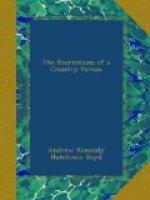One idea, you see, beaten out rather thin, and expressed in a great many words, as was the good man’s wont. And in these days of the misty and spasmodic school, I owe my readers an apology for presenting them with poetry which they will have no difficulty in understanding.
Amid a great number of particulars as to the burial customs of various nations, we find mention made of an odd way in which the natives of Thibet dignify their great people. They do not desecrate such by giving them to the earth, but retain a number of sacred dogs to devour them. Not less strange was the fancy of that Englishwoman, a century or two back, who had her husband burnt to ashes, and these ashes reduced to powder, of which she mixed some with all the water she drank, thinking, poor heart-broken creature, that, thus she was burying the dear form within her own.
In rare cases I have known of the parson or the churchwarden turning his cow to pasture in the churchyard, to the sad desecration of the place. It appears, however, that worse than this has been done, if we may judge from the following passage quoted by Mrs. Stone:—
1540. Proceedings in the Court of Archdeaconry of Colchester, Colne Wake. Notatur per iconimos dicte ecclesie yt the parson mysusithe the churche-yard, for hogis do wrote up graves, and besse lie in the porche, and ther the pavements he broke up and soyle the porche; and ther is so mych catell yt usithe the church-yarde, yt is more liker a pasture than a halowed place.
It is usual, it appears, in the southern parts of France, to erect in the churchyard a lofty pillar, bearing a large lamp, which throws its light upon the cemetery during the night. The custom began in the twelfth or thirteenth century. Sometimes the lanterne des marts was a highly ornamented chapel, built in a circular form, like the Church of the Holy Sepulchre at Jerusalem, in which the dead lay exposed to view in the days which preceded their interment: sometimes it was merely a hollow column, ascended by a winding stair inside, or by projections left for the purpose within. It must have been a striking sight when the traveller, through the dark night, saw far away the lonely flame that marked the spot where so many of his fellow-men had completed their journey.
One of the oddest things ever introduced into Materia Medica was the celebrated Mummy Powder. Egyptian mummies, being broken up and ground into dust, were held of great value as medicine both for external and internal application. Boyle and Bacon unite in commending its virtues: the latter, indeed, venturing to suggest that ‘the mixture of balms that are glutinous’ was the foundation of its power, though common belief held that the virtue was ’more in the Egyptian than in the spice.’ Even in the seventeenth century mummy was an important article of commerce, and was sold at a great price. One Eastern traveller brought to the Turkey Company six hundred weight of mummy broken into pieces.




